Analyzing Leadership & Management Roles in Operations at P&G
VerifiedAdded on 2023/06/18
|16
|4832
|75
Report
AI Summary
This report provides a detailed analysis of leadership and management roles within operations, using Procter & Gamble (P&G) as a case study. It defines and compares the roles and characteristics of leaders and managers, examining their application in various situational contexts, particularly focusing on how they address losses during the global pandemic. The report delves into different leadership theories, including situational, systems, and contingency leadership, and explores various leadership models such as adaptive, laissez-faire, and authoritative leadership. Key approaches to operations management are explained, highlighting the roles of leaders and managers in these approaches. Furthermore, the report discusses the importance and value of operations management in achieving business objectives and identifies factors within the business environment that impact operational management and decision-making by leaders and managers within the context of P&G.
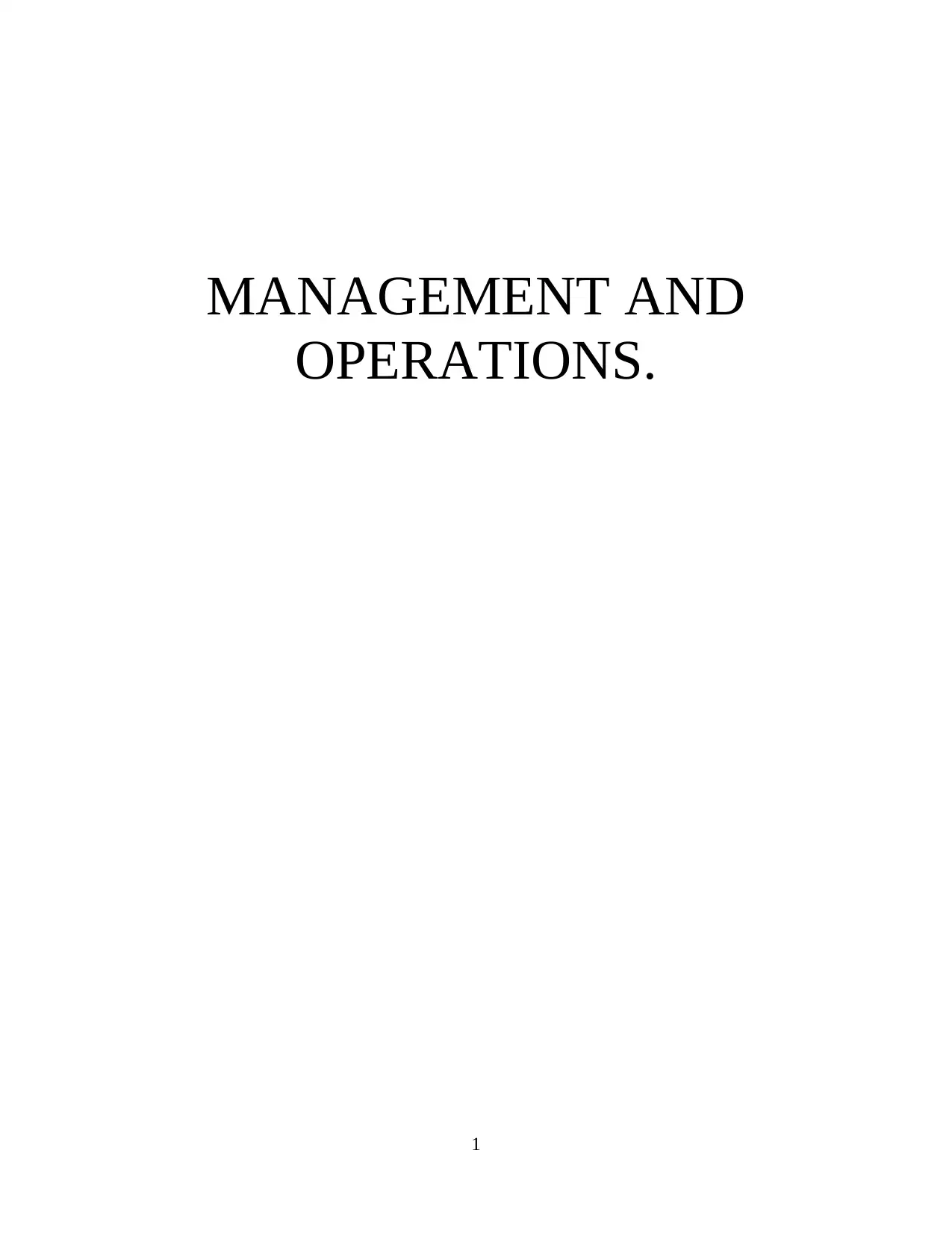
MANAGEMENT AND
OPERATIONS.
1
OPERATIONS.
1
Paraphrase This Document
Need a fresh take? Get an instant paraphrase of this document with our AI Paraphraser

Table of Contents:
INTRODUCTION...........................................................................................................................3
1. Define and compare the different roles and characteristics of a leader and a manager:..........3
Manager:............................................................................................................................3
Leader:...............................................................................................................................3
Differences between the role of Manager and Leader in the company:............................3
2. Examine examples of how the role of a leader and the function of a manager apply in
different situational contexts........................................................................................................6
The role of a leader to improve the situation:....................................................................6
The function of a manager to improve the situation:.........................................................7
3. Different theories and models or approaches to leadership:....................................................8
Theories of leadership:......................................................................................................8
4. Explaining the key approaches to operations management and the roles of leaders and
managers in them.......................................................................................................................10
5. The importance and value of operations management in achieving business objectives......11
6. Factors within the business environment that impact upon operational management and
decision-making by leaders and managers................................................................................12
CONCLUSION..............................................................................................................................14
REFERENCES..............................................................................................................................15
2
INTRODUCTION...........................................................................................................................3
1. Define and compare the different roles and characteristics of a leader and a manager:..........3
Manager:............................................................................................................................3
Leader:...............................................................................................................................3
Differences between the role of Manager and Leader in the company:............................3
2. Examine examples of how the role of a leader and the function of a manager apply in
different situational contexts........................................................................................................6
The role of a leader to improve the situation:....................................................................6
The function of a manager to improve the situation:.........................................................7
3. Different theories and models or approaches to leadership:....................................................8
Theories of leadership:......................................................................................................8
4. Explaining the key approaches to operations management and the roles of leaders and
managers in them.......................................................................................................................10
5. The importance and value of operations management in achieving business objectives......11
6. Factors within the business environment that impact upon operational management and
decision-making by leaders and managers................................................................................12
CONCLUSION..............................................................................................................................14
REFERENCES..............................................................................................................................15
2
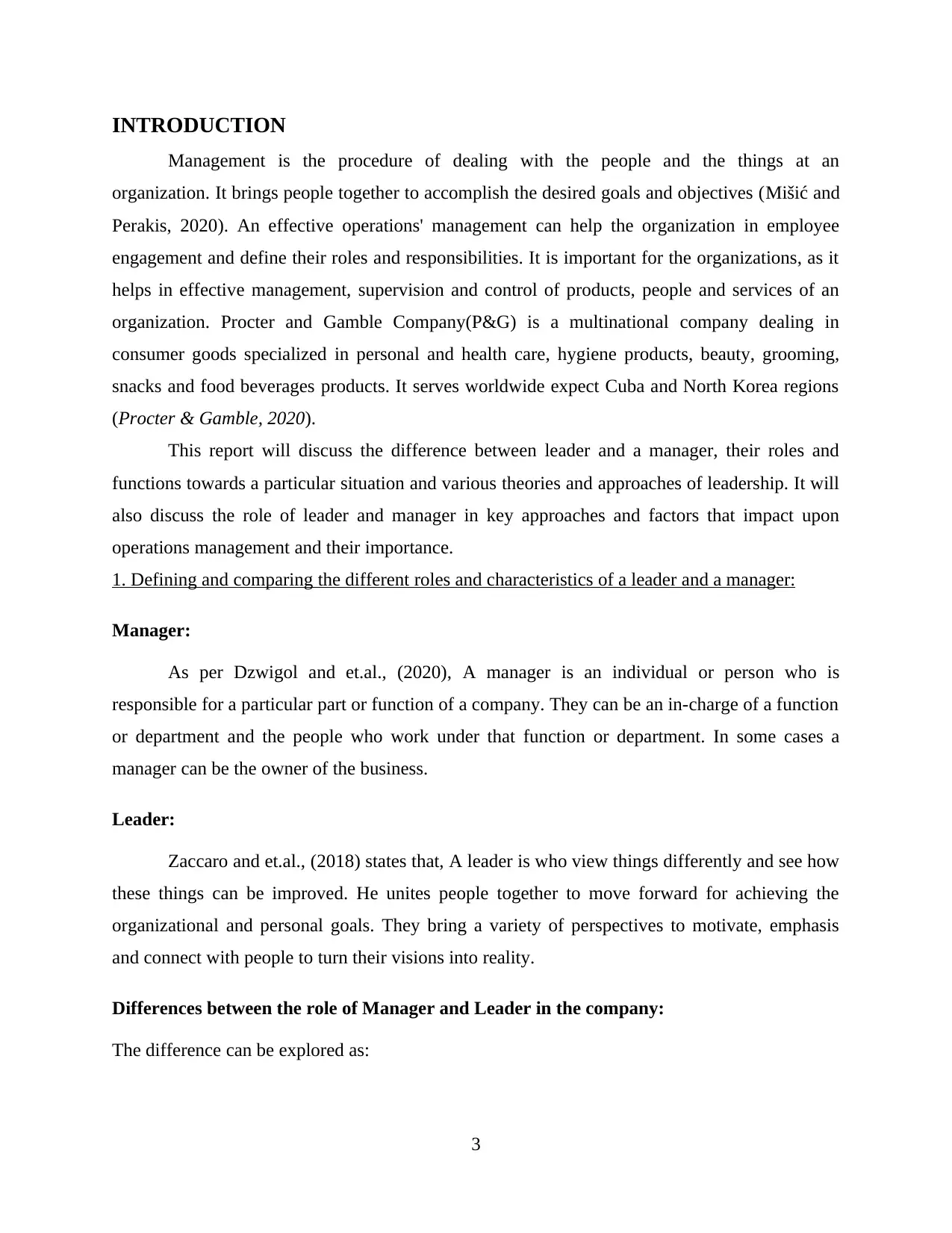
INTRODUCTION
Management is the procedure of dealing with the people and the things at an
organization. It brings people together to accomplish the desired goals and objectives (Mišić and
Perakis, 2020). An effective operations' management can help the organization in employee
engagement and define their roles and responsibilities. It is important for the organizations, as it
helps in effective management, supervision and control of products, people and services of an
organization. Procter and Gamble Company(P&G) is a multinational company dealing in
consumer goods specialized in personal and health care, hygiene products, beauty, grooming,
snacks and food beverages products. It serves worldwide expect Cuba and North Korea regions
(Procter & Gamble, 2020).
This report will discuss the difference between leader and a manager, their roles and
functions towards a particular situation and various theories and approaches of leadership. It will
also discuss the role of leader and manager in key approaches and factors that impact upon
operations management and their importance.
1. Defining and comparing the different roles and characteristics of a leader and a manager:
Manager:
As per Dzwigol and et.al., (2020), A manager is an individual or person who is
responsible for a particular part or function of a company. They can be an in-charge of a function
or department and the people who work under that function or department. In some cases a
manager can be the owner of the business.
Leader:
Zaccaro and et.al., (2018) states that, A leader is who view things differently and see how
these things can be improved. He unites people together to move forward for achieving the
organizational and personal goals. They bring a variety of perspectives to motivate, emphasis
and connect with people to turn their visions into reality.
Differences between the role of Manager and Leader in the company:
The difference can be explored as:
3
Management is the procedure of dealing with the people and the things at an
organization. It brings people together to accomplish the desired goals and objectives (Mišić and
Perakis, 2020). An effective operations' management can help the organization in employee
engagement and define their roles and responsibilities. It is important for the organizations, as it
helps in effective management, supervision and control of products, people and services of an
organization. Procter and Gamble Company(P&G) is a multinational company dealing in
consumer goods specialized in personal and health care, hygiene products, beauty, grooming,
snacks and food beverages products. It serves worldwide expect Cuba and North Korea regions
(Procter & Gamble, 2020).
This report will discuss the difference between leader and a manager, their roles and
functions towards a particular situation and various theories and approaches of leadership. It will
also discuss the role of leader and manager in key approaches and factors that impact upon
operations management and their importance.
1. Defining and comparing the different roles and characteristics of a leader and a manager:
Manager:
As per Dzwigol and et.al., (2020), A manager is an individual or person who is
responsible for a particular part or function of a company. They can be an in-charge of a function
or department and the people who work under that function or department. In some cases a
manager can be the owner of the business.
Leader:
Zaccaro and et.al., (2018) states that, A leader is who view things differently and see how
these things can be improved. He unites people together to move forward for achieving the
organizational and personal goals. They bring a variety of perspectives to motivate, emphasis
and connect with people to turn their visions into reality.
Differences between the role of Manager and Leader in the company:
The difference can be explored as:
3
⊘ This is a preview!⊘
Do you want full access?
Subscribe today to unlock all pages.

Trusted by 1+ million students worldwide
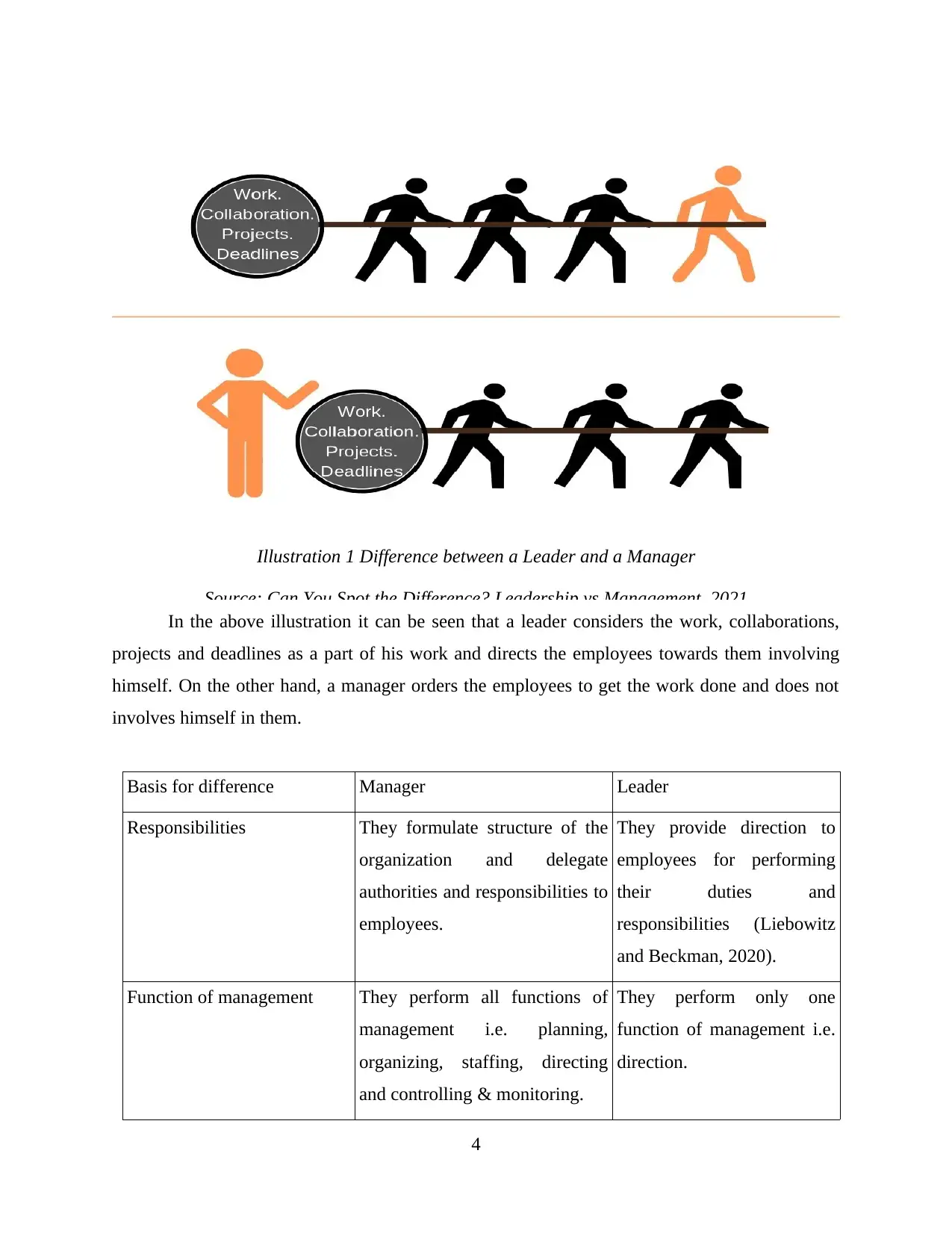
Illustration 1 Difference between a Leader and a Manager
Source: Can You Spot the Difference? Leadership vs Management, 2021
In the above illustration it can be seen that a leader considers the work, collaborations,
projects and deadlines as a part of his work and directs the employees towards them involving
himself. On the other hand, a manager orders the employees to get the work done and does not
involves himself in them.
Basis for difference Manager Leader
Responsibilities They formulate structure of the
organization and delegate
authorities and responsibilities to
employees.
They provide direction to
employees for performing
their duties and
responsibilities (Liebowitz
and Beckman, 2020).
Function of management They perform all functions of
management i.e. planning,
organizing, staffing, directing
and controlling & monitoring.
They perform only one
function of management i.e.
direction.
4
Source: Can You Spot the Difference? Leadership vs Management, 2021
In the above illustration it can be seen that a leader considers the work, collaborations,
projects and deadlines as a part of his work and directs the employees towards them involving
himself. On the other hand, a manager orders the employees to get the work done and does not
involves himself in them.
Basis for difference Manager Leader
Responsibilities They formulate structure of the
organization and delegate
authorities and responsibilities to
employees.
They provide direction to
employees for performing
their duties and
responsibilities (Liebowitz
and Beckman, 2020).
Function of management They perform all functions of
management i.e. planning,
organizing, staffing, directing
and controlling & monitoring.
They perform only one
function of management i.e.
direction.
4
Paraphrase This Document
Need a fresh take? Get an instant paraphrase of this document with our AI Paraphraser

Authorities They have formal authorities to
lay their role.
They have informal
authorities for their role in
the organization.
Approaches used They use reactive approach i.e.
they react to events after they
have happened (Gratton and
et.al., 2019).
They use proactive approach
i.e. they focus on eliminating
problems before they can
happen.
Existence in They can exist in both the formal
and informal structures.
They exist only in formal
structures.
Qualities required A manager is required to have
both the management and
leadership qualities.
A leader is required to have
leaderships qualities.
Motivational strategy used They use extrinsic approach i.e.
rewards and incentives are used
to motivate employees.
They use the intrinsic
approach i.e. motivation is
derived from within the
employees without giving
them external rewards.
Focus Their prime focus is the
processes of the company.
Their prime focus is on the
people of an organization
(King and et.al., 2020).
Strives for They strive for efficiency of
work and organization through
the employees.
They strive for effectiveness
in the employees.
Style of management They use transformational style
of management i.e. transforming
employees and processes to
achieve organizational goals.
They use transactional
management style i.e. they
focus on supervision of
performances and the
employees.
Change adoption They usually react to the They promote to adopt those
5
lay their role.
They have informal
authorities for their role in
the organization.
Approaches used They use reactive approach i.e.
they react to events after they
have happened (Gratton and
et.al., 2019).
They use proactive approach
i.e. they focus on eliminating
problems before they can
happen.
Existence in They can exist in both the formal
and informal structures.
They exist only in formal
structures.
Qualities required A manager is required to have
both the management and
leadership qualities.
A leader is required to have
leaderships qualities.
Motivational strategy used They use extrinsic approach i.e.
rewards and incentives are used
to motivate employees.
They use the intrinsic
approach i.e. motivation is
derived from within the
employees without giving
them external rewards.
Focus Their prime focus is the
processes of the company.
Their prime focus is on the
people of an organization
(King and et.al., 2020).
Strives for They strive for efficiency of
work and organization through
the employees.
They strive for effectiveness
in the employees.
Style of management They use transformational style
of management i.e. transforming
employees and processes to
achieve organizational goals.
They use transactional
management style i.e. they
focus on supervision of
performances and the
employees.
Change adoption They usually react to the They promote to adopt those
5
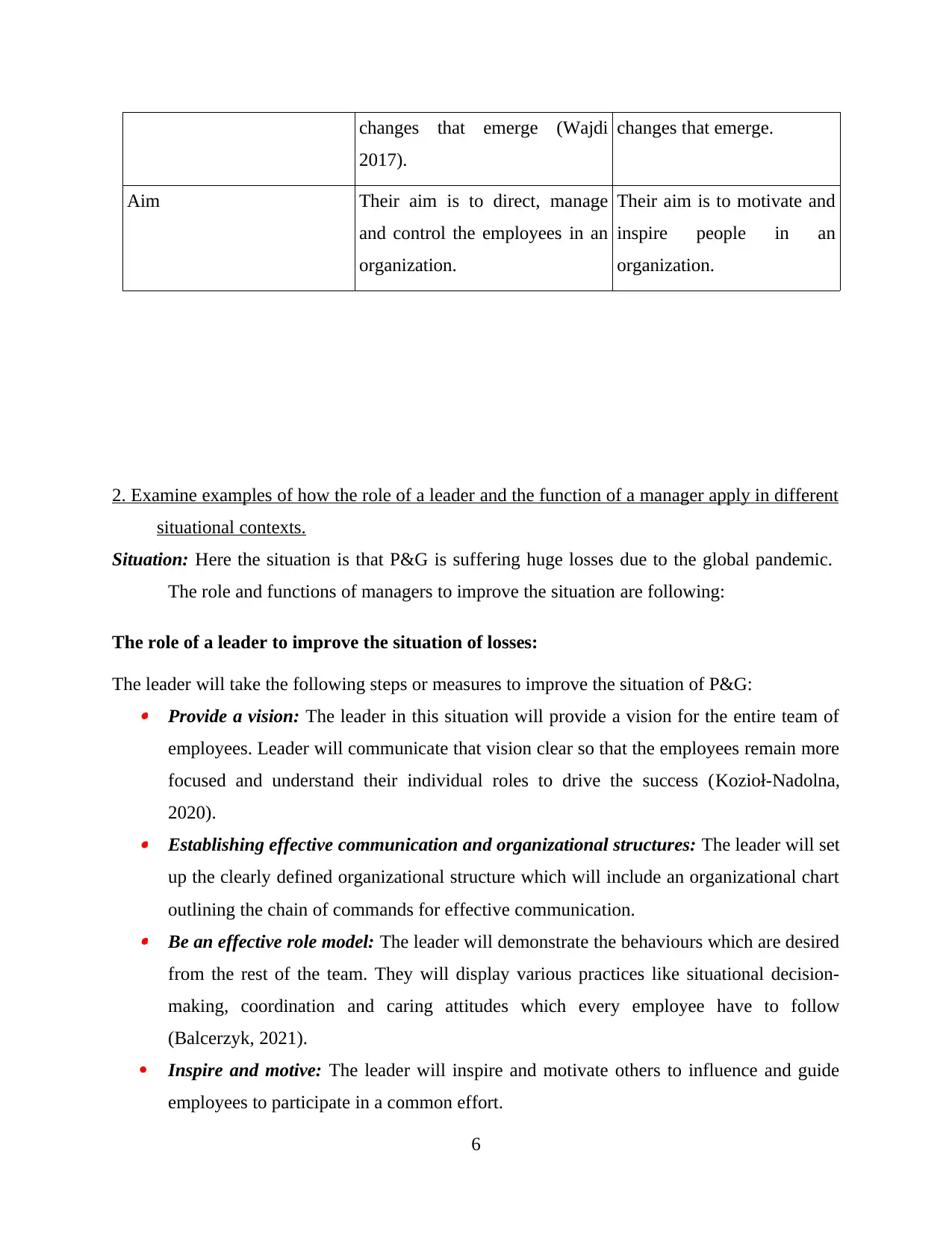
changes that emerge (Wajdi
2017).
changes that emerge.
Aim Their aim is to direct, manage
and control the employees in an
organization.
Their aim is to motivate and
inspire people in an
organization.
2. Examine examples of how the role of a leader and the function of a manager apply in different
situational contexts.
Situation: Here the situation is that P&G is suffering huge losses due to the global pandemic.
The role and functions of managers to improve the situation are following:
The role of a leader to improve the situation of losses:
The leader will take the following steps or measures to improve the situation of P&G: Provide a vision: The leader in this situation will provide a vision for the entire team of
employees. Leader will communicate that vision clear so that the employees remain more
focused and understand their individual roles to drive the success (Kozioł-Nadolna,
2020). Establishing effective communication and organizational structures: The leader will set
up the clearly defined organizational structure which will include an organizational chart
outlining the chain of commands for effective communication. Be an effective role model: The leader will demonstrate the behaviours which are desired
from the rest of the team. They will display various practices like situational decision-
making, coordination and caring attitudes which every employee have to follow
(Balcerzyk, 2021).
Inspire and motive: The leader will inspire and motivate others to influence and guide
employees to participate in a common effort.
6
2017).
changes that emerge.
Aim Their aim is to direct, manage
and control the employees in an
organization.
Their aim is to motivate and
inspire people in an
organization.
2. Examine examples of how the role of a leader and the function of a manager apply in different
situational contexts.
Situation: Here the situation is that P&G is suffering huge losses due to the global pandemic.
The role and functions of managers to improve the situation are following:
The role of a leader to improve the situation of losses:
The leader will take the following steps or measures to improve the situation of P&G: Provide a vision: The leader in this situation will provide a vision for the entire team of
employees. Leader will communicate that vision clear so that the employees remain more
focused and understand their individual roles to drive the success (Kozioł-Nadolna,
2020). Establishing effective communication and organizational structures: The leader will set
up the clearly defined organizational structure which will include an organizational chart
outlining the chain of commands for effective communication. Be an effective role model: The leader will demonstrate the behaviours which are desired
from the rest of the team. They will display various practices like situational decision-
making, coordination and caring attitudes which every employee have to follow
(Balcerzyk, 2021).
Inspire and motive: The leader will inspire and motivate others to influence and guide
employees to participate in a common effort.
6
⊘ This is a preview!⊘
Do you want full access?
Subscribe today to unlock all pages.

Trusted by 1+ million students worldwide
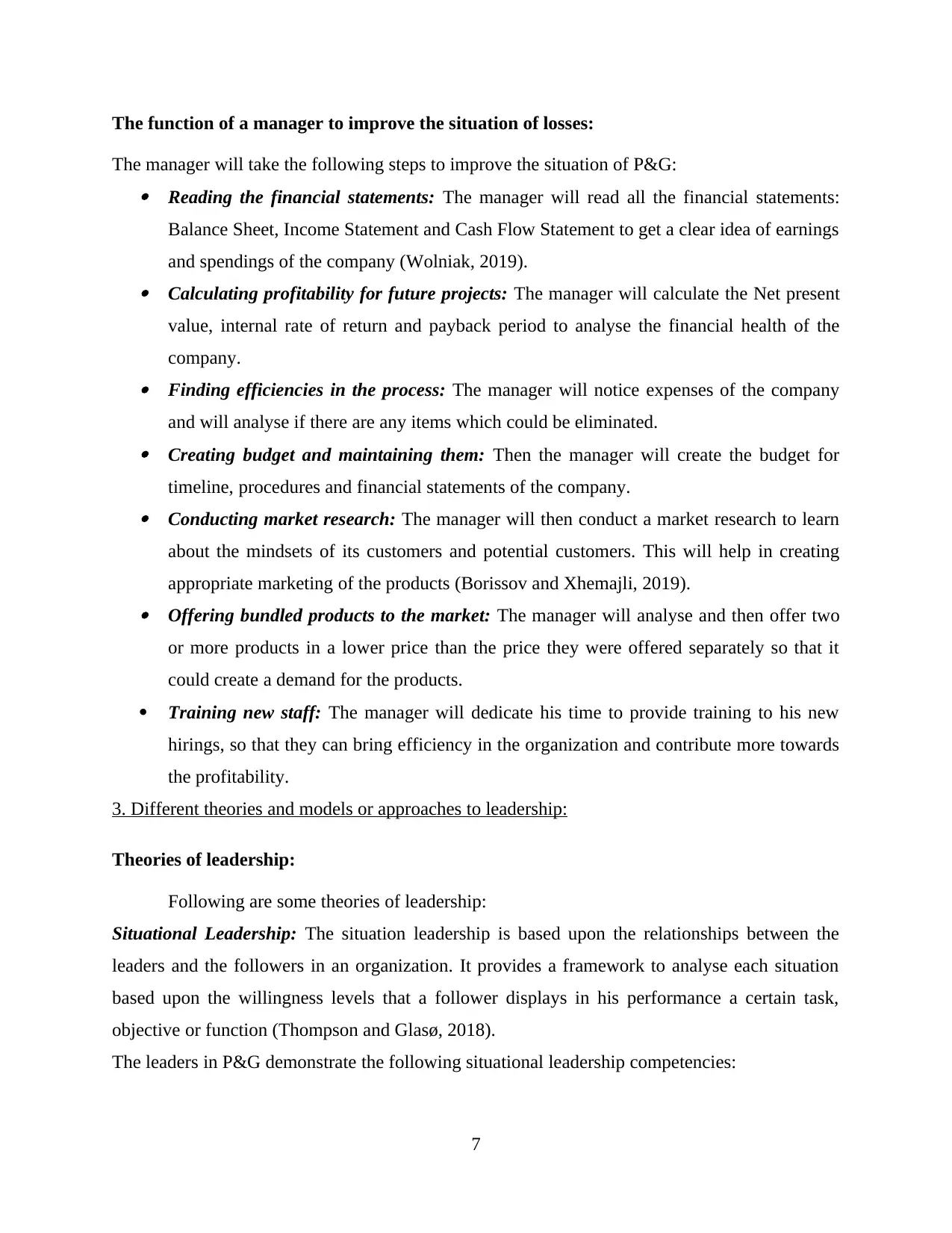
The function of a manager to improve the situation of losses:
The manager will take the following steps to improve the situation of P&G: Reading the financial statements: The manager will read all the financial statements:
Balance Sheet, Income Statement and Cash Flow Statement to get a clear idea of earnings
and spendings of the company (Wolniak, 2019). Calculating profitability for future projects: The manager will calculate the Net present
value, internal rate of return and payback period to analyse the financial health of the
company. Finding efficiencies in the process: The manager will notice expenses of the company
and will analyse if there are any items which could be eliminated. Creating budget and maintaining them: Then the manager will create the budget for
timeline, procedures and financial statements of the company. Conducting market research: The manager will then conduct a market research to learn
about the mindsets of its customers and potential customers. This will help in creating
appropriate marketing of the products (Borissov and Xhemajli, 2019). Offering bundled products to the market: The manager will analyse and then offer two
or more products in a lower price than the price they were offered separately so that it
could create a demand for the products.
Training new staff: The manager will dedicate his time to provide training to his new
hirings, so that they can bring efficiency in the organization and contribute more towards
the profitability.
3. Different theories and models or approaches to leadership:
Theories of leadership:
Following are some theories of leadership:
Situational Leadership: The situation leadership is based upon the relationships between the
leaders and the followers in an organization. It provides a framework to analyse each situation
based upon the willingness levels that a follower displays in his performance a certain task,
objective or function (Thompson and Glasø, 2018).
The leaders in P&G demonstrate the following situational leadership competencies:
7
The manager will take the following steps to improve the situation of P&G: Reading the financial statements: The manager will read all the financial statements:
Balance Sheet, Income Statement and Cash Flow Statement to get a clear idea of earnings
and spendings of the company (Wolniak, 2019). Calculating profitability for future projects: The manager will calculate the Net present
value, internal rate of return and payback period to analyse the financial health of the
company. Finding efficiencies in the process: The manager will notice expenses of the company
and will analyse if there are any items which could be eliminated. Creating budget and maintaining them: Then the manager will create the budget for
timeline, procedures and financial statements of the company. Conducting market research: The manager will then conduct a market research to learn
about the mindsets of its customers and potential customers. This will help in creating
appropriate marketing of the products (Borissov and Xhemajli, 2019). Offering bundled products to the market: The manager will analyse and then offer two
or more products in a lower price than the price they were offered separately so that it
could create a demand for the products.
Training new staff: The manager will dedicate his time to provide training to his new
hirings, so that they can bring efficiency in the organization and contribute more towards
the profitability.
3. Different theories and models or approaches to leadership:
Theories of leadership:
Following are some theories of leadership:
Situational Leadership: The situation leadership is based upon the relationships between the
leaders and the followers in an organization. It provides a framework to analyse each situation
based upon the willingness levels that a follower displays in his performance a certain task,
objective or function (Thompson and Glasø, 2018).
The leaders in P&G demonstrate the following situational leadership competencies:
7
Paraphrase This Document
Need a fresh take? Get an instant paraphrase of this document with our AI Paraphraser

Firstly they diagnose an individual employee's performance willingness to complete a
specific task.
They adapt leader behaviour based upon the diagnosis. They communicate an influential approach in such a manner that the employees can both
understand and accept.
Systems Leadership: The systems leadership allows the leaders of an organization to create the
conditions where the employees at all the levels of management can work productively to their
potentials. This leadership theory uses appropriate principles of human behaviours to create
models of a good leadership, strategies, processes and systems designs. This leadership provides
the leaders tools through which they can predict employee's behaviour in the organization
(Macdonald, Burke and Stewart, 2018).
For example: The leaders of P&G can use Systems Leadership to build an
effective system which can drive productive behaviour and lead them towards a more effective
realization of the organizational objectives.
Contingency Leadership: This theory of leadership states that the effectiveness of a leader can
be dependent upon a particular situation which suits their leadership style. It is assumed that a
leader cannot be effective in all the situations i.e. He can be an effective leader in one situation
and in another situation he can be ineffective. This theory requires the leaders to be self-aware in
examining each situation and decide if their leadership style will be effective or not (Yin and
et.al., 2017).
For example: In P&G the leaders analyse the factors like team size, scope or the date of
project and then decide their leadership style that they will be using. They adapt the leadership
style according to the need and type of the product.
Models or approaches to Leadership:
The various models of leadership can be explained as follows:
Adaptive Leadership: The adaptive leadership model is the act of deploying a group of
individuals to handle the problems or the challenges and then emerge successful in the end. This
leadership style focus on the importance of adoption of a complex and rapidly changing
8
specific task.
They adapt leader behaviour based upon the diagnosis. They communicate an influential approach in such a manner that the employees can both
understand and accept.
Systems Leadership: The systems leadership allows the leaders of an organization to create the
conditions where the employees at all the levels of management can work productively to their
potentials. This leadership theory uses appropriate principles of human behaviours to create
models of a good leadership, strategies, processes and systems designs. This leadership provides
the leaders tools through which they can predict employee's behaviour in the organization
(Macdonald, Burke and Stewart, 2018).
For example: The leaders of P&G can use Systems Leadership to build an
effective system which can drive productive behaviour and lead them towards a more effective
realization of the organizational objectives.
Contingency Leadership: This theory of leadership states that the effectiveness of a leader can
be dependent upon a particular situation which suits their leadership style. It is assumed that a
leader cannot be effective in all the situations i.e. He can be an effective leader in one situation
and in another situation he can be ineffective. This theory requires the leaders to be self-aware in
examining each situation and decide if their leadership style will be effective or not (Yin and
et.al., 2017).
For example: In P&G the leaders analyse the factors like team size, scope or the date of
project and then decide their leadership style that they will be using. They adapt the leadership
style according to the need and type of the product.
Models or approaches to Leadership:
The various models of leadership can be explained as follows:
Adaptive Leadership: The adaptive leadership model is the act of deploying a group of
individuals to handle the problems or the challenges and then emerge successful in the end. This
leadership style focus on the importance of adoption of a complex and rapidly changing
8

environment and creating the situations for good leadership and problem solving. It states that
leadership is a price not a characteristic that is inherent (Obolensky, 2017).
For example: The leaders of P&G have adopted this leadership style which mean they
focus on coordination so that the employees can adopt the changes in market and external
environments.
Laissez-Fair Leadership: This leadership style states that the leader have confidence on their
employees, and they can rely completely upon their employees. The employees are not micro-
managed by the leaders, nor they are given too much of instructions or guidances. Leaders give
them appropriate guidance and the employees take responsibilities where it is needed. The
decision-making is completely in the hands of the employees (Breevaart and Zacher, 2019).
For example: The employees in P&G uses Laissez-faire leadership in between the small
groups of their departments. Although, they are not given full authorities instead they are given
relevant authorities which are needed to perform their tasks.
Authoritative Leadership: It is the most common and effective leadership model but is often
controversial. In this leadership model the leaders do whatever it takes to complete a task or
objective from their employees. If this leadership model is used appropriately then it can help the
leaders to make quick and effective decisions and keep their employees motivated at their best
levels. Here the leader have full control on goal setting, processes and procedures to reach goals
of organization by getting inputs from employees (Goleman, 2017).
For example: In P&G this leadership model is used in the higher level of management
where all the decisions related to the production are taken by the BODs.
4. Explaining the key approaches to operations management and the roles of leaders and
managers in them.
Some key approaches to operations management in an organization and the role that
managers and leaders have in that process is following:
Kaizen: Kaizen is an approach of management which means to change for better or continuous
improvement. It is the management of the processes that continuous improve the operations and
involve all the employees in it. They see the improvements in the productivity as a positive and
methodical process (Helmold, 2020).
9
leadership is a price not a characteristic that is inherent (Obolensky, 2017).
For example: The leaders of P&G have adopted this leadership style which mean they
focus on coordination so that the employees can adopt the changes in market and external
environments.
Laissez-Fair Leadership: This leadership style states that the leader have confidence on their
employees, and they can rely completely upon their employees. The employees are not micro-
managed by the leaders, nor they are given too much of instructions or guidances. Leaders give
them appropriate guidance and the employees take responsibilities where it is needed. The
decision-making is completely in the hands of the employees (Breevaart and Zacher, 2019).
For example: The employees in P&G uses Laissez-faire leadership in between the small
groups of their departments. Although, they are not given full authorities instead they are given
relevant authorities which are needed to perform their tasks.
Authoritative Leadership: It is the most common and effective leadership model but is often
controversial. In this leadership model the leaders do whatever it takes to complete a task or
objective from their employees. If this leadership model is used appropriately then it can help the
leaders to make quick and effective decisions and keep their employees motivated at their best
levels. Here the leader have full control on goal setting, processes and procedures to reach goals
of organization by getting inputs from employees (Goleman, 2017).
For example: In P&G this leadership model is used in the higher level of management
where all the decisions related to the production are taken by the BODs.
4. Explaining the key approaches to operations management and the roles of leaders and
managers in them.
Some key approaches to operations management in an organization and the role that
managers and leaders have in that process is following:
Kaizen: Kaizen is an approach of management which means to change for better or continuous
improvement. It is the management of the processes that continuous improve the operations and
involve all the employees in it. They see the improvements in the productivity as a positive and
methodical process (Helmold, 2020).
9
⊘ This is a preview!⊘
Do you want full access?
Subscribe today to unlock all pages.

Trusted by 1+ million students worldwide

The manager in Kaizen will be responsible for a group of employees who will work
towards identifying quality improvements while the leader will be responsible for planning and
helping the employees to facilitate Kaizen events.
Just in Time: It a process which aims at increasing value added and also eliminating waste
activities or processes by providing the environment perfect and simplified processes (Maeng,
and Lucia, 2019).
The manager introduces JIN in the organization to reduce the costs by eliminating
wasteful or non-useful activities and processes, while the leader will help the employees to adapt
to Just In Time process.
Six Sigma: Six sigma is a group of tools and techniques used for process improvements. It
focuses on improvements in product cycle time while at the same time reducing manufacturing
defects or wastages to a certain level.
The manager create and foster an environment which sets the stage for all the employees
by clearly defining their roles and responsibilities, while the leader leads the overall effort and
responsibility for improving the projects undertaken by the company. He is responsible for the
team to go.
Lean Management: Lean management is a process about continuously improving work
processes, people and purposes of an organization. Lean management encourages the shared
responsibility and shared leadership instead of holding total control of work processes and keeping
the spotlight on one thing only (Singh and Rathi, 2019). It is base upon the two pillars:
Continuous improvements and Respect for all the people in the organization.
The manager's role in this process is to optimize the production or service processes,
while the role of leader is to raises new leaders and help the employees to embrace a culture of
continuous improvements.
Queuing theory: It is the approach to study the information, process, function or congestion of
the waiting queues of products or processes in the management. It can help the organization to
make informed business decisions on how to build efficient and cost effective workflow systems
(Memon, Li and Ahmed, 2019).
10
towards identifying quality improvements while the leader will be responsible for planning and
helping the employees to facilitate Kaizen events.
Just in Time: It a process which aims at increasing value added and also eliminating waste
activities or processes by providing the environment perfect and simplified processes (Maeng,
and Lucia, 2019).
The manager introduces JIN in the organization to reduce the costs by eliminating
wasteful or non-useful activities and processes, while the leader will help the employees to adapt
to Just In Time process.
Six Sigma: Six sigma is a group of tools and techniques used for process improvements. It
focuses on improvements in product cycle time while at the same time reducing manufacturing
defects or wastages to a certain level.
The manager create and foster an environment which sets the stage for all the employees
by clearly defining their roles and responsibilities, while the leader leads the overall effort and
responsibility for improving the projects undertaken by the company. He is responsible for the
team to go.
Lean Management: Lean management is a process about continuously improving work
processes, people and purposes of an organization. Lean management encourages the shared
responsibility and shared leadership instead of holding total control of work processes and keeping
the spotlight on one thing only (Singh and Rathi, 2019). It is base upon the two pillars:
Continuous improvements and Respect for all the people in the organization.
The manager's role in this process is to optimize the production or service processes,
while the role of leader is to raises new leaders and help the employees to embrace a culture of
continuous improvements.
Queuing theory: It is the approach to study the information, process, function or congestion of
the waiting queues of products or processes in the management. It can help the organization to
make informed business decisions on how to build efficient and cost effective workflow systems
(Memon, Li and Ahmed, 2019).
10
Paraphrase This Document
Need a fresh take? Get an instant paraphrase of this document with our AI Paraphraser
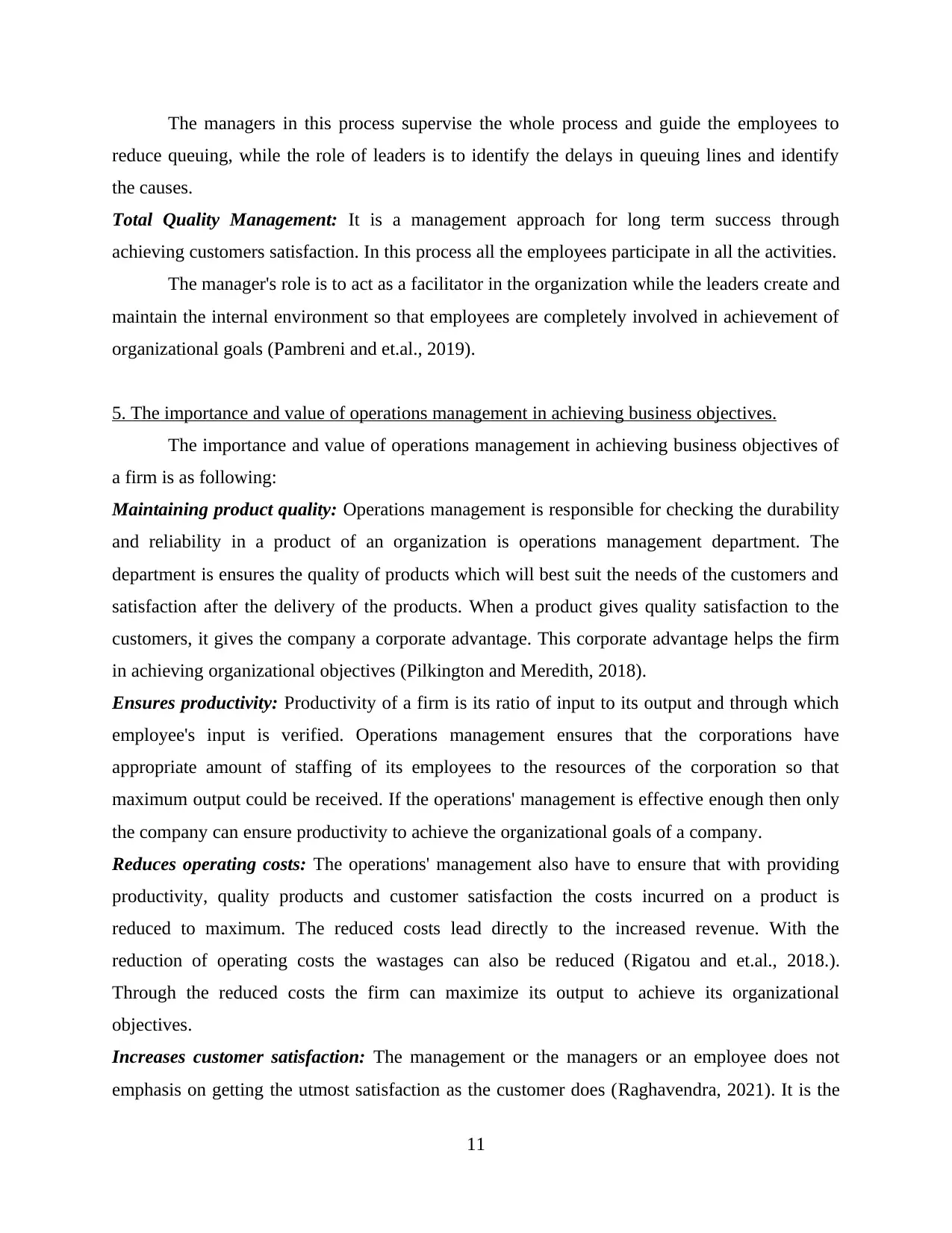
The managers in this process supervise the whole process and guide the employees to
reduce queuing, while the role of leaders is to identify the delays in queuing lines and identify
the causes.
Total Quality Management: It is a management approach for long term success through
achieving customers satisfaction. In this process all the employees participate in all the activities.
The manager's role is to act as a facilitator in the organization while the leaders create and
maintain the internal environment so that employees are completely involved in achievement of
organizational goals (Pambreni and et.al., 2019).
5. The importance and value of operations management in achieving business objectives.
The importance and value of operations management in achieving business objectives of
a firm is as following:
Maintaining product quality: Operations management is responsible for checking the durability
and reliability in a product of an organization is operations management department. The
department is ensures the quality of products which will best suit the needs of the customers and
satisfaction after the delivery of the products. When a product gives quality satisfaction to the
customers, it gives the company a corporate advantage. This corporate advantage helps the firm
in achieving organizational objectives (Pilkington and Meredith, 2018).
Ensures productivity: Productivity of a firm is its ratio of input to its output and through which
employee's input is verified. Operations management ensures that the corporations have
appropriate amount of staffing of its employees to the resources of the corporation so that
maximum output could be received. If the operations' management is effective enough then only
the company can ensure productivity to achieve the organizational goals of a company.
Reduces operating costs: The operations' management also have to ensure that with providing
productivity, quality products and customer satisfaction the costs incurred on a product is
reduced to maximum. The reduced costs lead directly to the increased revenue. With the
reduction of operating costs the wastages can also be reduced (Rigatou and et.al., 2018.).
Through the reduced costs the firm can maximize its output to achieve its organizational
objectives.
Increases customer satisfaction: The management or the managers or an employee does not
emphasis on getting the utmost satisfaction as the customer does (Raghavendra, 2021). It is the
11
reduce queuing, while the role of leaders is to identify the delays in queuing lines and identify
the causes.
Total Quality Management: It is a management approach for long term success through
achieving customers satisfaction. In this process all the employees participate in all the activities.
The manager's role is to act as a facilitator in the organization while the leaders create and
maintain the internal environment so that employees are completely involved in achievement of
organizational goals (Pambreni and et.al., 2019).
5. The importance and value of operations management in achieving business objectives.
The importance and value of operations management in achieving business objectives of
a firm is as following:
Maintaining product quality: Operations management is responsible for checking the durability
and reliability in a product of an organization is operations management department. The
department is ensures the quality of products which will best suit the needs of the customers and
satisfaction after the delivery of the products. When a product gives quality satisfaction to the
customers, it gives the company a corporate advantage. This corporate advantage helps the firm
in achieving organizational objectives (Pilkington and Meredith, 2018).
Ensures productivity: Productivity of a firm is its ratio of input to its output and through which
employee's input is verified. Operations management ensures that the corporations have
appropriate amount of staffing of its employees to the resources of the corporation so that
maximum output could be received. If the operations' management is effective enough then only
the company can ensure productivity to achieve the organizational goals of a company.
Reduces operating costs: The operations' management also have to ensure that with providing
productivity, quality products and customer satisfaction the costs incurred on a product is
reduced to maximum. The reduced costs lead directly to the increased revenue. With the
reduction of operating costs the wastages can also be reduced (Rigatou and et.al., 2018.).
Through the reduced costs the firm can maximize its output to achieve its organizational
objectives.
Increases customer satisfaction: The management or the managers or an employee does not
emphasis on getting the utmost satisfaction as the customer does (Raghavendra, 2021). It is the
11
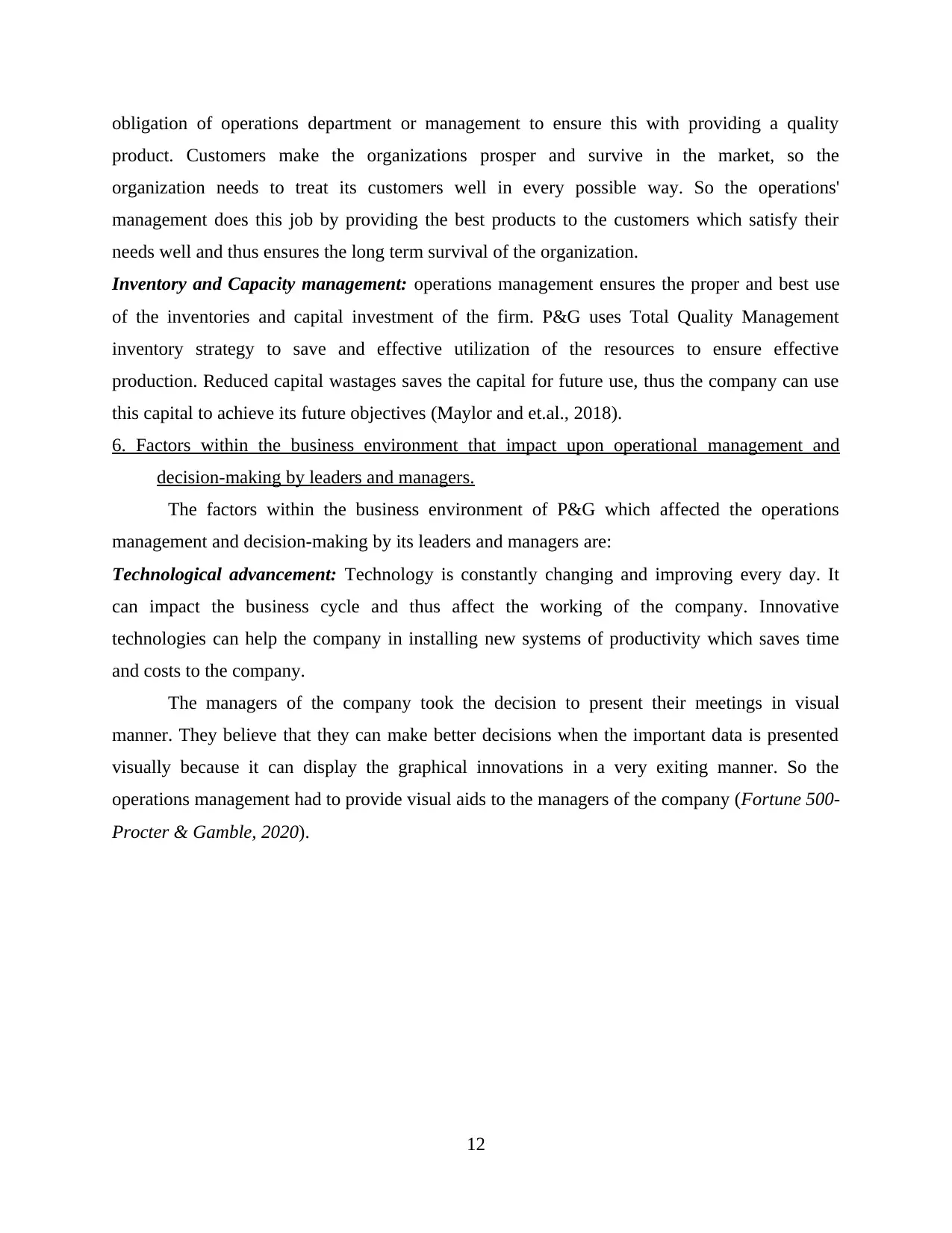
obligation of operations department or management to ensure this with providing a quality
product. Customers make the organizations prosper and survive in the market, so the
organization needs to treat its customers well in every possible way. So the operations'
management does this job by providing the best products to the customers which satisfy their
needs well and thus ensures the long term survival of the organization.
Inventory and Capacity management: operations management ensures the proper and best use
of the inventories and capital investment of the firm. P&G uses Total Quality Management
inventory strategy to save and effective utilization of the resources to ensure effective
production. Reduced capital wastages saves the capital for future use, thus the company can use
this capital to achieve its future objectives (Maylor and et.al., 2018).
6. Factors within the business environment that impact upon operational management and
decision-making by leaders and managers.
The factors within the business environment of P&G which affected the operations
management and decision-making by its leaders and managers are:
Technological advancement: Technology is constantly changing and improving every day. It
can impact the business cycle and thus affect the working of the company. Innovative
technologies can help the company in installing new systems of productivity which saves time
and costs to the company.
The managers of the company took the decision to present their meetings in visual
manner. They believe that they can make better decisions when the important data is presented
visually because it can display the graphical innovations in a very exiting manner. So the
operations management had to provide visual aids to the managers of the company (Fortune 500-
Procter & Gamble, 2020).
12
product. Customers make the organizations prosper and survive in the market, so the
organization needs to treat its customers well in every possible way. So the operations'
management does this job by providing the best products to the customers which satisfy their
needs well and thus ensures the long term survival of the organization.
Inventory and Capacity management: operations management ensures the proper and best use
of the inventories and capital investment of the firm. P&G uses Total Quality Management
inventory strategy to save and effective utilization of the resources to ensure effective
production. Reduced capital wastages saves the capital for future use, thus the company can use
this capital to achieve its future objectives (Maylor and et.al., 2018).
6. Factors within the business environment that impact upon operational management and
decision-making by leaders and managers.
The factors within the business environment of P&G which affected the operations
management and decision-making by its leaders and managers are:
Technological advancement: Technology is constantly changing and improving every day. It
can impact the business cycle and thus affect the working of the company. Innovative
technologies can help the company in installing new systems of productivity which saves time
and costs to the company.
The managers of the company took the decision to present their meetings in visual
manner. They believe that they can make better decisions when the important data is presented
visually because it can display the graphical innovations in a very exiting manner. So the
operations management had to provide visual aids to the managers of the company (Fortune 500-
Procter & Gamble, 2020).
12
⊘ This is a preview!⊘
Do you want full access?
Subscribe today to unlock all pages.

Trusted by 1+ million students worldwide
1 out of 16
Related Documents
Your All-in-One AI-Powered Toolkit for Academic Success.
+13062052269
info@desklib.com
Available 24*7 on WhatsApp / Email
![[object Object]](/_next/static/media/star-bottom.7253800d.svg)
Unlock your academic potential
Copyright © 2020–2025 A2Z Services. All Rights Reserved. Developed and managed by ZUCOL.




